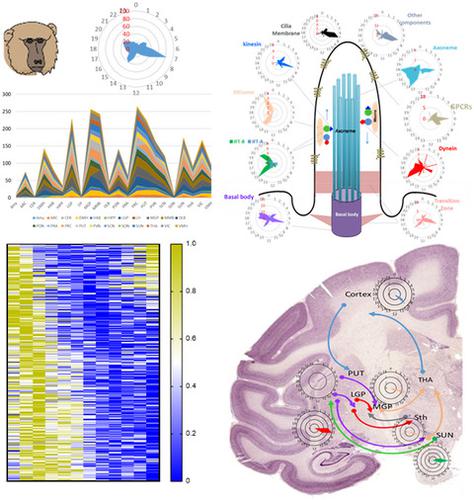当前位置:
X-MOL 学术
›
J. Neurosci. Res.
›
论文详情
Our official English website, www.x-mol.net, welcomes your feedback! (Note: you will need to create a separate account there.)
Large-scale analysis reveals spatiotemporal circadian patterns of cilia transcriptomes in the primate brain
Journal of Neuroscience Research ( IF 4.2 ) Pub Date : 2021-07-26 , DOI: 10.1002/jnr.24919 Pierre Baldi 1, 2 , Wedad Alhassen 3 , Siwei Chen 1, 2 , Henry Nguyen 3 , Mohammad Khoudari 3 , Amal Alachkar 2, 3
Journal of Neuroscience Research ( IF 4.2 ) Pub Date : 2021-07-26 , DOI: 10.1002/jnr.24919 Pierre Baldi 1, 2 , Wedad Alhassen 3 , Siwei Chen 1, 2 , Henry Nguyen 3 , Mohammad Khoudari 3 , Amal Alachkar 2, 3
Affiliation

|
Cilia are dynamic subcellular systems, with core structural and functional components operating in a highly coordinated manner. Since many environmental stimuli sensed by cilia are circadian in nature, it is reasonable to speculate that genes encoding cilia structural and functional components follow rhythmic circadian patterns of expression. Using computational methods and the largest spatiotemporal gene expression atlas of primates, we identified and analyzed the circadian rhythmic expression of cilia genes across 22 primate brain areas. We found that around 73% of cilia transcripts exhibited circadian rhythmicity across at least one of 22 brain regions. In 12 brain regions, cilia transcriptomes were significantly enriched with circadian oscillating transcripts, as compared to the rest of the transcriptome. The phase of the cilia circadian transcripts deviated from the phase of the majority of the background circadian transcripts, and transcripts coding for cilia basal body components accounted for the majority of cilia circadian transcripts. In addition, adjacent or functionally connected brain nuclei had large overlapping complements of circadian cilia genes. Most remarkably, cilia circadian transcripts shared across the basal ganglia nuclei and the prefrontal cortex peaked in these structures in sequential fashion that is similar to the sequential order of activation of the basal ganglia-cortical circuitry in connection with movement coordination, albeit on completely different timescales. These findings support a role for the circadian spatiotemporal orchestration of cilia gene expression in the normal physiology of the basal ganglia-cortical circuit and motor control. Studying orchestrated cilia rhythmicity in the basal ganglia-cortical circuits and other brain circuits may help develop better functional models, and shed light on the causal effects cilia functions have on these circuits and on the regulation of movement and other behaviors.
中文翻译:

大规模分析揭示灵长类动物大脑纤毛转录组的时空昼夜节律模式
纤毛是动态的亚细胞系统,其核心结构和功能组件以高度协调的方式运行。由于纤毛感知的许多环境刺激本质上是昼夜节律的,因此推测编码纤毛结构和功能成分的基因遵循有节律的昼夜节律表达模式是合理的。使用计算方法和最大的灵长类时空基因表达图谱,我们识别并分析了 22 个灵长类大脑区域纤毛基因的昼夜节律表达。我们发现,大约 73% 的纤毛转录本在 22 个大脑区域中的至少一个区域中表现出昼夜节律。与转录组的其余部分相比,在 12 个大脑区域中,纤毛转录组显着富含昼夜振荡转录本。纤毛昼夜节律转录本的相位偏离了大多数背景昼夜节律转录本的相位,并且编码纤毛基底体成分的转录本占纤毛昼夜节律转录本的大部分。此外,相邻或功能连接的脑核具有大量重叠的昼夜纤毛基因。最值得注意的是,基底神经节核和前额叶皮层共享的纤毛昼夜节律转录本在这些结构中以顺序方式达到峰值,这类似于与运动协调相关的基底神经节 - 皮质电路的激活顺序,尽管时间尺度完全不同. 这些发现支持纤毛基因表达的昼夜节律时空编排在基底神经节 - 皮质回路和运动控制的正常生理学中的作用。研究基底神经节 - 皮质回路和其他大脑回路中协调的纤毛节律性可能有助于开发更好的功能模型,并阐明纤毛功能对这些回路以及运动和其他行为的调节的因果影响。
更新日期:2021-07-26
中文翻译:

大规模分析揭示灵长类动物大脑纤毛转录组的时空昼夜节律模式
纤毛是动态的亚细胞系统,其核心结构和功能组件以高度协调的方式运行。由于纤毛感知的许多环境刺激本质上是昼夜节律的,因此推测编码纤毛结构和功能成分的基因遵循有节律的昼夜节律表达模式是合理的。使用计算方法和最大的灵长类时空基因表达图谱,我们识别并分析了 22 个灵长类大脑区域纤毛基因的昼夜节律表达。我们发现,大约 73% 的纤毛转录本在 22 个大脑区域中的至少一个区域中表现出昼夜节律。与转录组的其余部分相比,在 12 个大脑区域中,纤毛转录组显着富含昼夜振荡转录本。纤毛昼夜节律转录本的相位偏离了大多数背景昼夜节律转录本的相位,并且编码纤毛基底体成分的转录本占纤毛昼夜节律转录本的大部分。此外,相邻或功能连接的脑核具有大量重叠的昼夜纤毛基因。最值得注意的是,基底神经节核和前额叶皮层共享的纤毛昼夜节律转录本在这些结构中以顺序方式达到峰值,这类似于与运动协调相关的基底神经节 - 皮质电路的激活顺序,尽管时间尺度完全不同. 这些发现支持纤毛基因表达的昼夜节律时空编排在基底神经节 - 皮质回路和运动控制的正常生理学中的作用。研究基底神经节 - 皮质回路和其他大脑回路中协调的纤毛节律性可能有助于开发更好的功能模型,并阐明纤毛功能对这些回路以及运动和其他行为的调节的因果影响。



























 京公网安备 11010802027423号
京公网安备 11010802027423号